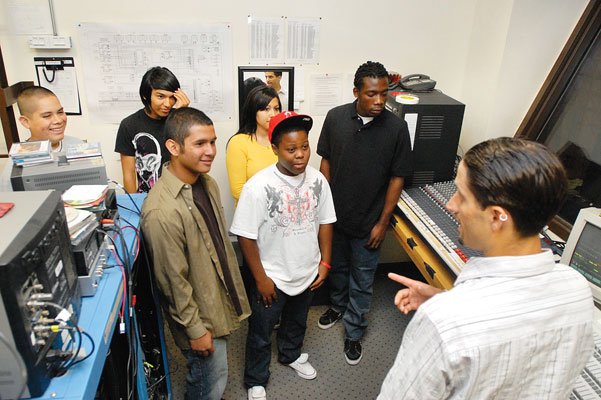Akeem Love came 3,000 miles to become a star. Like half a dozen
local teens, Love will spend the next two months learning the ropes
both in front of and behind the camera as a summer intern at the
Community Media Access Partnership, or CMAP, located on the Gavilan
College campus.
Akeem Love came 3,000 miles to become a star. Like half a dozen local teens, Love will spend the next two months learning the ropes both in front of and behind the camera as a summer intern at the Community Media Access Partnership, or CMAP, located on the Gavilan College campus.
A natural in front of the camera, the 15-year-old from Atlanta improvised a freestyle rap, substituting a nearby remote control for a microphone while his peers focused their cameras on him, learning the basics of lighting, camera angle and sound checks.
“This is not at all what I expected on the first day,” Love said.
CMAP Executive Director Kathy Bisbee didn’t waste a minute on book work or small talk with the teens. They dove right in on their first day, an indication of what the rest of the summer will bring. Over the next couple months, the teens will work as production assistants covering local events, editing footage and marketing community content for the Web and to air on CMAP’s cable channels. The positions are funded on a one-time basis by federal stimulus dollars allocated by President Barack Obama with the hope that, if all goes well, the funds may be renewable, said Enrique Arreola, deputy director of community services and workforce development in San Benito County, one of the agencies that referred its youth to CMAP.
On top of the cutting edge experience the students will gain by working in the studio and out in the field, they’ll learn old-fashioned skills like conducting a professional telephone conversation and composing a business letter, Bisbee said.
“For many of these youth, it is their first opportunity to learn basic office skills, teamwork and professional communication,” she said. “Some are unsure of what they can do in this economy, or haven’t yet explored career options. At their first job, they are excited to serve their community, learn video production and earn their first paycheck. It’s a great opportunity for the youth and for CMAP.”
CMAP is a public access television station and community media center operating five channels featuring locally produced public access, government and education content. The nonprofit serves Gilroy, San Juan Bautista and Hollister and offers free and low-cost training on cameras, lighting, field and studio production, digital storytelling and editing to community members, Bisbee said. The nonprofit was particularly excited to launch this pilot program for teens, she said.
“It seemed like a perfect fit,” Bisbee said after learning about federal stimulus dollars that were flowing into nonprofits to fund programs like the one CMAP developed. Bisbee got into the business when she was not much older than some of her interns, she said, and having an adult mentor to look up to is a “foot in the door.”
Most students came to CMAP by way of their local career centers and earn minimum wage – $8 per hour – thanks to federal stimulus dollars. The career centers use stimulus funds to pay the youth, the youth work at area nonprofits and the nonprofits gain valuable extra hands while imparting essential career training, Arreola said.
“It’s a huge win-win for everyone,” he said, pointing out how the CMAP program is a perfect example of federal aid being put to use at the local level. With California’s unemployment hitting a record high at 11.5 percent earlier this year, youth may have a harder time finding jobs. Several of the teens come from low income families and never held a job before, Bisbee added.
“We really want them to come out of the program knowing what it means to have a job and be able to put together a resume and communicate professionally,” Bisbee said.
Timid at first, the teens gradually came out of their shells as Bisbee led them into the studio and instructed them to take places either behind several large cameras or in the spotlight.
Mario Discua, 15, of Hollister stood off camera and spoke thoughtfully about his dreams for the future. His eyes lit up when he talked about his hopes to become a director or an actor – or maybe a screenwriter.
“This seemed like the right place to start,” he said, gesturing to the cavernous studio. “I’m glad I got the opportunity. Most of this stuff is all new to me.”
The teenagers will be out and about this summer, taking turns covering the Gilroy Garlic Festival and other local events as well as putting together a regular television show about the issues facing the community. The topic, however, is still up in the air.
CMAP staff also have their hands full with summer camp programs at public schools. About 80 middle school students are currently enrolled in the programs that take place at Brownell Middle School on Carmel Street and the site of the former El Portal Leadership Academy campus on IOOF Avenue.
“It’s great to see that ‘I get it’ moment on the kids’ faces,” Bisbee said. “To place cameras into the hands of youth and allow them to tell the stories of the community really empowers them. Community media stations are some of the last places you can do that in America.”















